The most successful design projects are often a reflection of a harmonious partnership between the client and the agency or studio that they worked with to realize a vision. The rebrand for NYC-based CO_LAB Theater Group, created with award-winning agency Design Bridge and Partners, is a true testament to that dynamic. As a non-profit offering individuals with developmental disabilities a creative and social outlet through theater arts, CO_LAB looked to Design Bridge and Partners for a new look to reflect its important work. Meanwhile, Design Bridge and Partners selected CO_LAB as an organization to work with pro bono through their summer internship program. Theirs was a match made in heaven, producing a stellar brand that represents the CO_LAB ethos through and through.
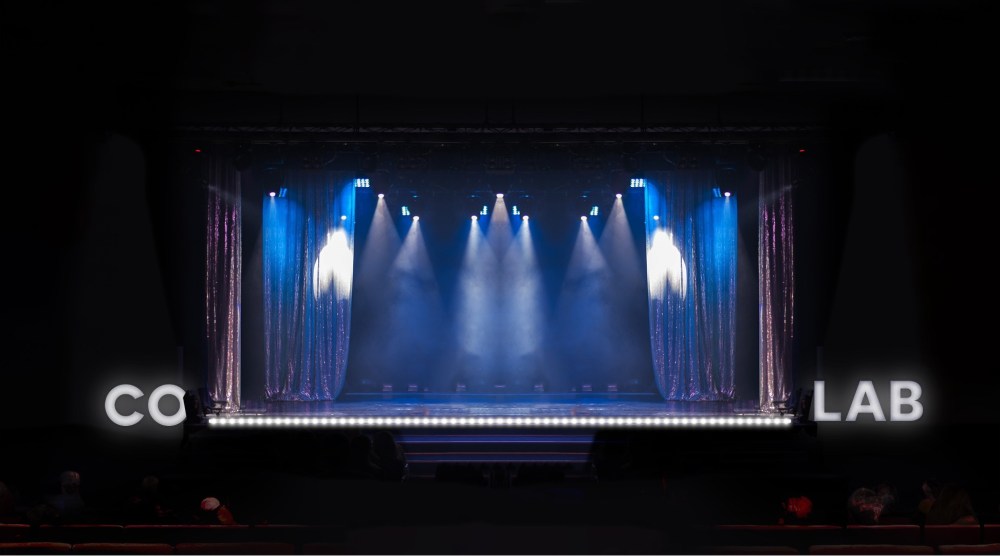
Since its conception in 2011, CO_LAB has been consulting on accessibility and disability inclusion for Off-Broadway companies like New York City Center, as well as commercial productions like the recent Broadway run of How To Dance In Ohio. CO_LAB adamantly creates an open and inclusive safe space for creative expression for people of all abilities, and Design Bridge and Partners was keen to keep this mission at the center of every aspect of the rebrand. Prioritizing accessibility was a critical component, as was capturing the proper tone of the organization.
I recently spoke to members of the CO_LAB and Design Bridge and Partners teams about the project to learn more about the rebrand and their process of working together. My conversation with CO_LAB Executive Director David E. Shane, founding member of CO_LAB and Design Bridge and Partners’ Client Business Director Chris Pesto, and Creative Director Scott Lambert, is transcribed below (edited lightly for clarity and length).
How did this relationship between CO_LAB and Design Bridge and Partners develop? What brief did Design Bridge and Partners bring to CO_LAB for this project?
CP: Back probably around this time last year, I was interviewing with Design Bridge and Partners, and one of the questions that was asked of me was, “Tell me about your life outside of work?” Obviously, I’m very passionate about CO_LAB, and I spoke about my involvement. The head of talent whom I was interviewing with said, “Oh, my goodness, we always do pro bono work every summer as an internship program. We hire two interns each within Design Strategy and Client Partnership and do a project for a different nonprofit.” They were in the thick of vetting those nonprofits at the time.
A few months later, I was working at Design Bridge and Partners, and we engaged the executive director of CO_LAB at the time. Historically, we’ve done a promotional video, maybe a landing page for some of the nonprofits we’ve worked with in the past, but this was a special opportunity because nothing was off limits. CO_LAB had an appetite to do a complete rebrand, which was an incredible opportunity not only for the interns but for the rest of us as well. It’s not every day that creatives and strategists get to engage in a full rebrand of an organization, especially one that has great meaning.
It’s hard to do a full rebrand of an organization in one summer with interns whom we are teaching on top of our day jobs. So we did the first round of creative with our interns, and since then, we have taken it all the way through. With Scott’s leadership, we’ve completely developed the full suite of the system that we ultimately delivered to CO_LAB.
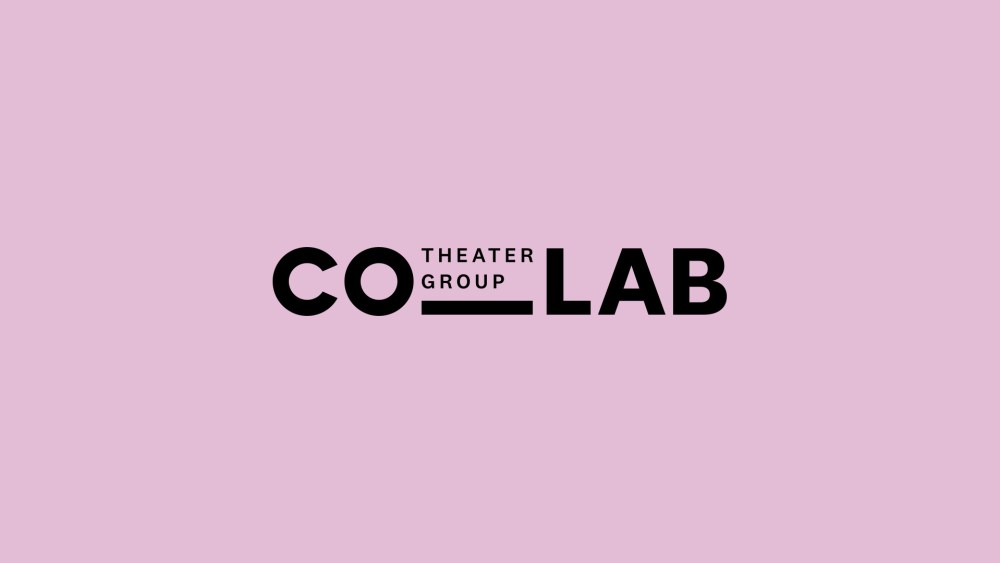
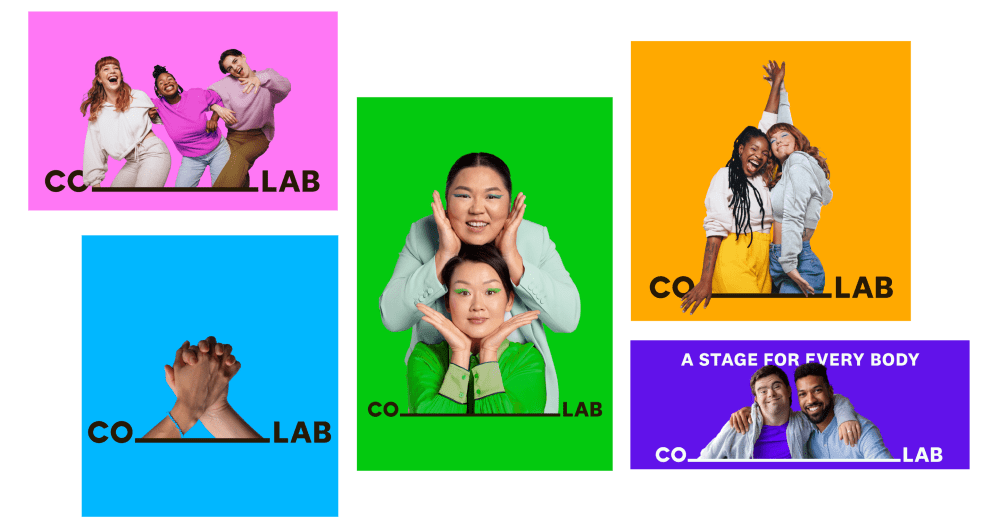
DS: I wasn’t the executive director yet, but I was around CO_LAB at the time, and one thing that I think is unique about this partnership is that CO_LAB didn’t come forward with a strong brief upfront. The brief was really about process rather than product. The real directive was to say, How do we engage our whole community to learn about the identity of CO_LAB from the actual people who make CO_LAB what it is? And how do we incorporate that into some sort of design package in the long term? I think that’s a really different approach than we’re looking for X. Instead, we really wanted this to organically be true and authentic to CO_LAB, and that means you have to talk to a lot of people in CO_LAB’s community, including staff and board members and the actors we work with, supporters, and donors. That process was the real directive that led to such an exciting end product.
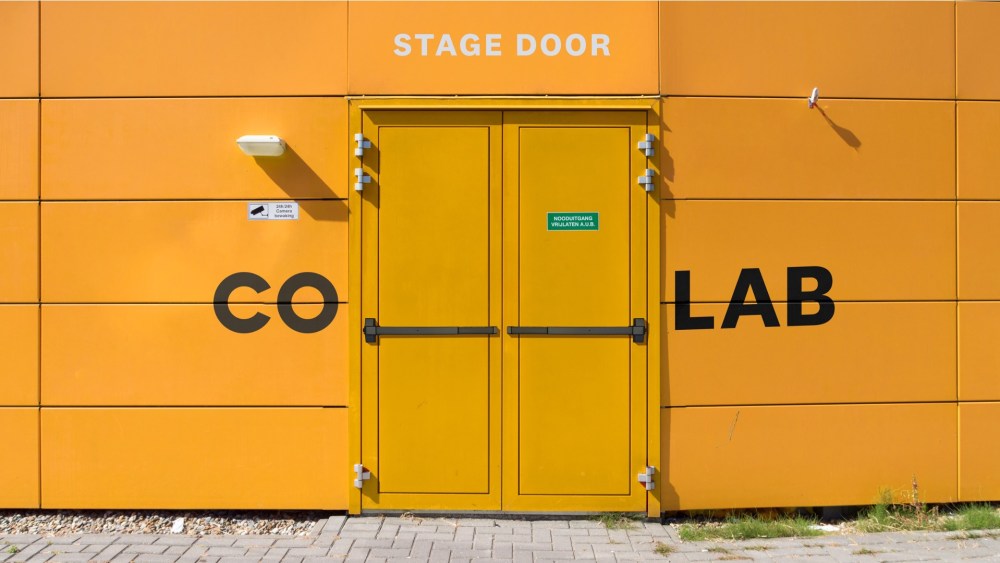
Can you share more about the process of this originally being an intern-led rebrand? Why did CO_LAB specifically lend itself to material that was so well-suited for interns to learn from?
CP: The internship program at Design Bridge and Partners is about creating a safe space for learning and presenting. CO_LAB is a dream client for interns to present to—they’re in a safe space to be able to fail in front of the clients while they’re presenting because that’s exactly what we do at CO_LAB. We want to get up and be silly, and it’s not about getting things right all the time. The “getting things right” was part two of the engagement. With the interns, it was about exploring and being able to learn as much as possible during the program.

Why did you decide to continue the rebrand with your full-time staff after the internship concluded?
SL: The internship program was amazing— you could sense the energy from the client leadership interns, the strategy interns, the creative interns. But realistically, where we were at the end of the program didn’t fully and authentically tell the CO_LAB story. Rather than just say that’s it, we were like, we’re in this. Let’s take this all the way and make this the best it can be. Let’s represent these incredible people and this incredible organization and follow through on that commitment.
DS: That’s really indicative of what it is to work at CO_LAB. When you work with folks with intellectual and developmental disabilities, communication just takes longer. That doesn’t mean that the communication is less fruitful or less interesting; it just sometimes takes longer. If you zoom out a little bit, that’s also true of what it is to work with CO_LAB as an organization. We move in such a way that we consider the input of a lot of different constituents when we make decisions, and that just takes longer than it does, sometimes, in a more hierarchical situation.
So what I appreciate about what Design Bridge and Partners did was they aligned with the idea that to be authentic, to be truly creative, you have to give time and space for the creativity to emerge. They also took a breath and said, “Okay, well, then we will take longer.” And that alignment makes a huge difference in the long run.


Accessibility is an important aspect of this rebrand because of the community you work with at CO_LAB. Can you speak a bit more about what considerations went into that aspect of the project?
CP: We would have failed CO_LAB if we didn’t keep going because we needed to continue to push on that accessibility. In the community that we work with, a lot of them have been with us since the beginning, and a rebrand could be a really big change for them. Some of them rely on signage to get to their classroom and know where they’re going, get to a rehearsal, or go to a theater where they’ve never been before, and they need to be able to recognize CO_LAB’s name and visuals. So we needed to be really careful about how to keep our community at the forefront of that but not lose the vibrancy.
When we got to that final round with the creative, we had really struck gold, making sure that every color was accessible, making sure that the font was as legible as possible. There was this challenge of, how do we keep it vibrant, but accessible? And I think we landed in such a nice space.

In terms of that space that you landed in with the rebrand, the stage motif is clearly at the core of it and is so clever both visually and symbolically. The tagline “Everybody’s Stage” is also so strong. How did you all develop those two concepts?
SL: “Everybody’s Stage” came from the interns, so that’s a lovely part of the story. Of course, our strategy team did a lot of work, all the interviews, to get to that point. It was an incredible effort, with people going above and beyond to get there and to get something that articulates CO_LAB so well.
We landed on this idea called “A stage for every story,” which is, of course, quite close to “everybody’s stage.” There’s a nice duality to “a stage for every story”, where every production is a story, but also every story of every tutor, every actor, and everybody who helps; everybody has a story, and CO_LAB is creating a stage for all of those.
There are a lot of traps you could fall into. One would be trying to make it too serious, and the other would be to make it too silly. And really, what David touched upon in the beginning is that it just needed to be authentic. It would be easy to try and make this about graphic design or brand design. It would be easy to try and make it about a branding agency. But actually what we did was try to get out of the way and create a system where the vibrancy, the stories came from the people on the stages. That was the “a-ha!” moment; it’s not about us, it’s not about branding, it’s about these incredible people who act and are creative and empower other people to act and be creative in an authentic way.
They took CO_LAB’s old logo, knocked down a barrier, and created a stage for stories to be told.
David E. Shane, CO_LAB
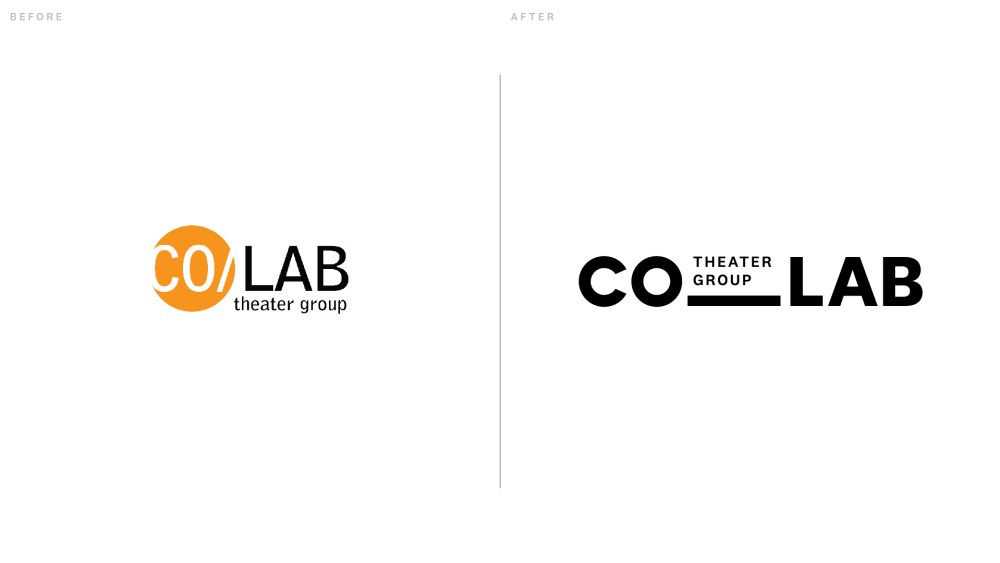
DS: The way in which the concept of “Everybody’s Stage” was then visualized was so meaningful, and not just in the sense that it functions the way that it does by expanding and contracting. Prior to this, CO_LAB has always been written as CO slash LAB. “COLAB” stands for “Creative Opportunities without Limits And Boundaries,” and the slash has always signified that. But literally, visually, a slash is a barrier, in a way, that a stage is not. So they actually did this thing, visually, where they took CO_LAB’s old logo, knocked down a barrier, and created a stage for stories to be told. And while that feels so simple, it’s actually incredibly powerful from a storytelling standpoint and has been one of the ways that we’ve been able to start to integrate this new design with our actors, many of whom, as Chris said, have been used to the old logo for so long. The story of the logo going from A to B is really, in and of itself, compelling and has helped a lot of our community understand how powerful this tool can be.
SL: What became apparent really quickly interacting with people from CO_LAB and hearing them talk, is the creativity itself. The system, you can see in the video, works best when you allow people to create with it— the way they pull it apart, the way they stand on it, the way they imagine it’s above their head. Of course, it was superimposed; none of it was there. To make the system work, the system needs their creativity. It needs them to react, interact, and act with it. The system is in service of them and the people.
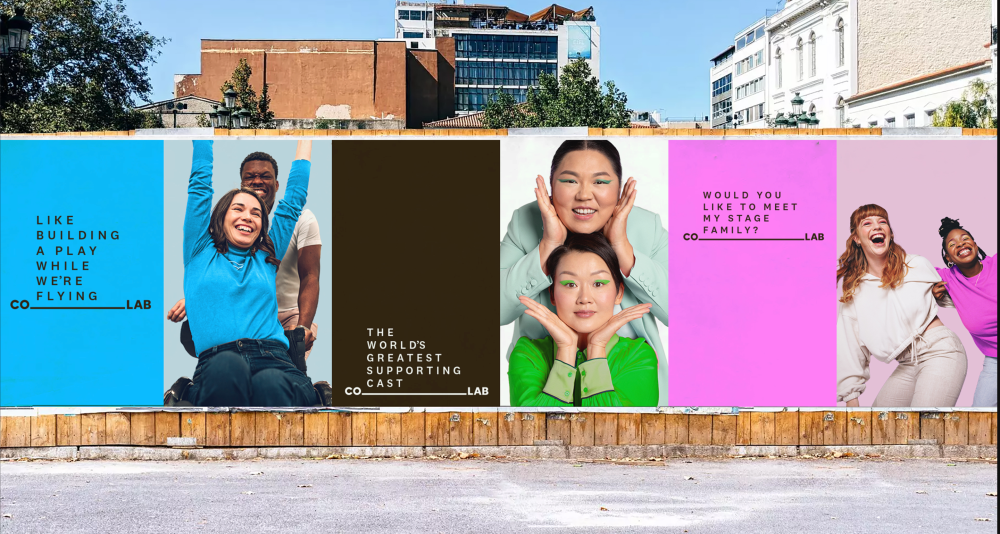
It would be easy to try and make this about graphic design or brand design. It would be easy to try and make it about a branding agency. But actually what we did was try to get out of the way and create a system where the vibrancy, the stories came from the people on the stages.
Scott Lambert, Design Bridge and Partners
What aspects of this project are you the proudest of?
SL: One is that everybody at Design Bridge and Partners, from the interns through the New York team to even our chief creative officer in London, was part of this journey and contributed to it. The second is, at the end of the film, the line should have been, “The only role to play is being you,” and the actor said, “The only role to play…” and paused, “is being me.” And Chris, who was in the shoot, said, “We’re keeping that.” And I was like, “Hell yeah.” That was one of my favorite moments.
BS: I wasn’t in that shoot, and I didn’t know that, and that’s incredible. That’s what CO_LAB is right there. We’re not aiming for, “This is the line, and this is how you say it.” We’re aiming for, “You have space to be you and say the thing that you need to say, and we’re going to give you the time to say it in a way that not every aspect of society does.” So the fact that that actually made its way into this video is mind-blowing to me, but also, of course it did, because that’s what CO_LAB is right there.
The other thing I’ll say is the tone with which Design Bridge and Partners approached the project, that balance between not-too-serious and not-too-silly is the tone with which they worked with all of us, including our actors, and that means a lot to me as a person who cares deeply for the people that we work with. We were working with values-aligned partners; this was a real partnership in every sense of the word.
It just meant so much to [the interns] to not only land the work but to do right by the community and the individuals that they had met along the way.
Chris Pesto, Design Bridge and Partners
CP: Throughout the whole process, I felt so vulnerable. I felt very exposed sitting at my desk, having something that I helped build from the ground up for the last decade being worked on on people’s computer screens. It was very emotional throughout.
One memorable moment was when I was moved to tears in the first round of the strategy, when the interns went through everything. Particularly because when we work with brands day in and day out, there are really specific things we learn in different reviews about what words they do and do not say, but it’s a little different with CO_LAB because it’s not just about what the brand’s saying, it’s about what we’re saying at the community. So we had interns using “IDD” as an acronym for “Intellectual and Developmental Disabilities,” which is not wrong, it’s completely fine to say that, but we just have a different way of talking about disability at CO_LAB where we’re really celebrating and being proud of our abilities and disabilities. They really tapped into the language of CO_LAB by the time they were presenting. I had given that feedback to the strategy interns, and they were also moved to tears. It just meant so much to them to not only land the work but to do right by the community and the individuals that they had met along the way.
The post CO_LAB Theater Group Teams Up with Design Bridge and Partners for an Accessible and Inclusive Rebrand appeared first on PRINT Magazine.








